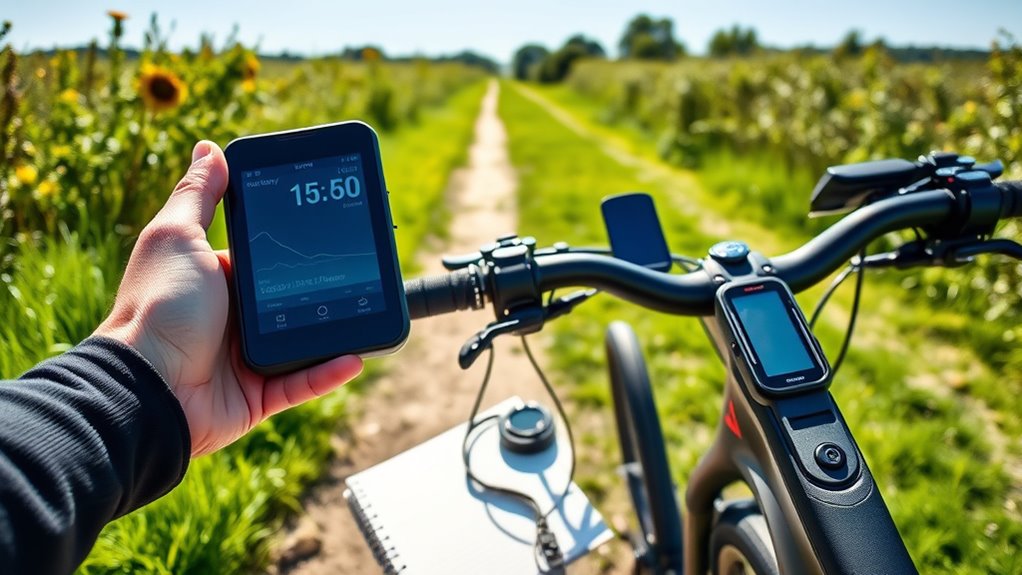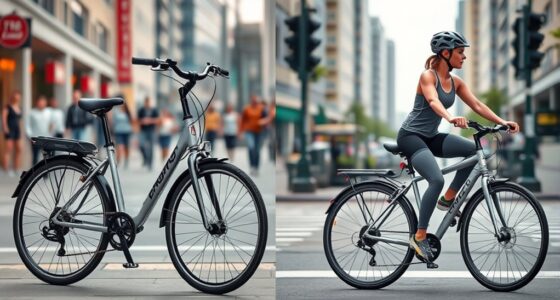To measure your e-bike’s range accurately, start by fully charging the battery and selecting a consistent route with similar terrain and conditions. Keep track of your starting settings, monitor power usage throughout the ride, and record the distance traveled. Repeat this process under different conditions to gather reliable data. Using apps or built-in tools can help you analyze your results. Keep exploring to discover detailed tips for precise and dependable range measurements.
Key Takeaways
- Fully calibrate the battery by charging and discharging to reset the management system before testing.
- Use a consistent, flat route with stable terrain and similar weather conditions for reliable comparisons.
- Record initial battery percentage, voltage, assist level, and ride distance accurately during each test.
- Monitor real-time power consumption and note wattage, current draw, and energy used throughout the ride.
- Repeat tests under consistent conditions, analyze the data to calculate average range, and adjust for external factors.
Prepare Your E-Bike and Equipment
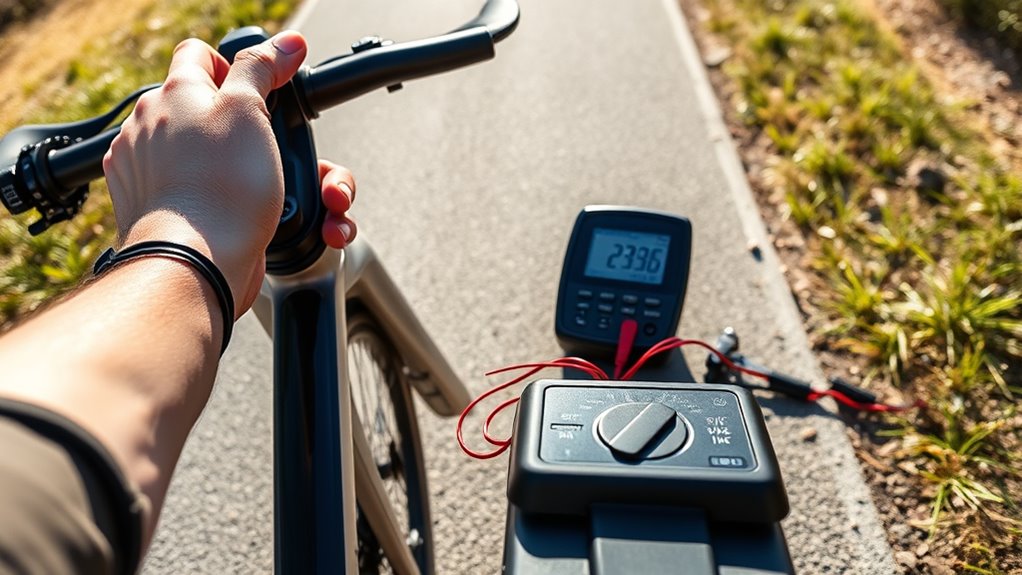
Before measuring your e-bike’s range, you need to make certain it’s fully prepared. Start with battery calibration: verify the battery is properly calibrated by fully charging and then fully discharging it to reset the battery management system. This helps provide accurate readings during testing. Next, check your tire pressure; properly inflated tires reduce rolling resistance and give you a more reliable measure of range. Use a pressure gauge to inflate tires to the manufacturer’s recommended PSI. Make sure your bike is in good working condition, with brakes and gears functioning smoothly. Remove unnecessary accessories that might add extra weight, and ensure your riding mode is set to a consistent level. These steps establish a solid baseline for accurate range measurement. Additionally, understanding the contrast ratio of your e-bike’s display can help you better interpret your battery life and performance metrics during rides.
Fully Charge Your Battery Before Testing
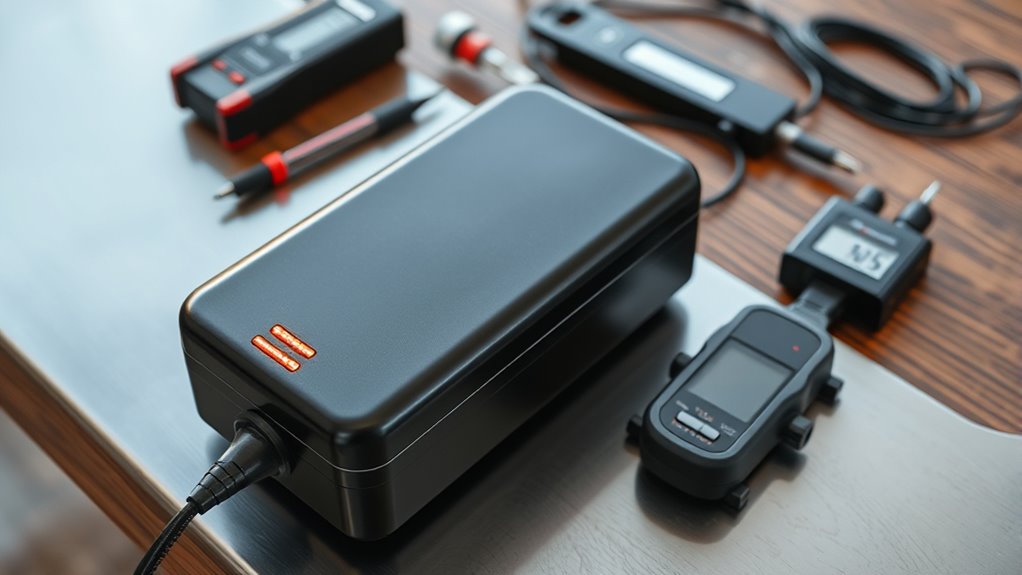
Ensure your battery is fully charged before testing your e-bike’s range. A full charge guarantees you measure the maximum battery capacity, providing accurate results. Use proper charging tips, like avoiding overcharging and charging in a cool, dry place, to maintain battery health. Before starting, ensure the battery indicator shows a complete charge. This consistency helps you compare results over time. Here’s a quick reference:
| Charging Tips | Purpose |
|---|---|
| Use original charger | Prevents damage and guarantees full charge |
| Charge in a cool environment | Protects battery health |
| Avoid overcharging | Extends battery lifespan |
| Fully drain before charging | Ensures accurate capacity measurement |
| Keep contacts clean | Maintains efficient charging |
Following these tips ensures you accurately gauge your e-bike’s range. Proper charging practices are essential for maintaining battery performance over time.
Choose a Consistent Testing Route
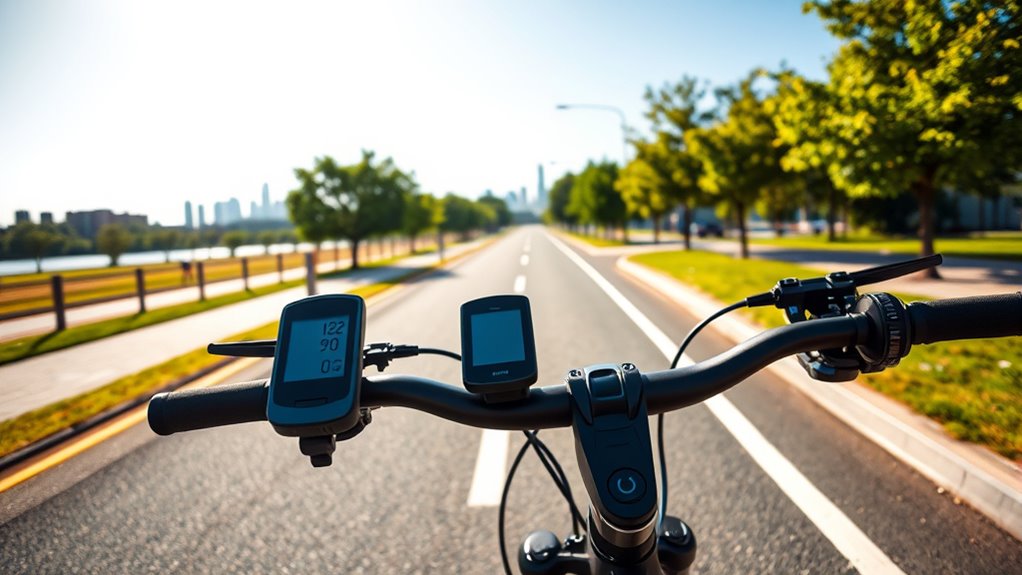
To get reliable and comparable results, you should choose a consistent testing route for measuring your e-bike’s range. Avoid route variation by selecting the same path each time you test. This helps ensure that factors like distance, elevation, and surface type stay consistent, making your results more accurate. A route with steady terrain, rather than steep hills or varied surfaces, minimizes unpredictable influences on your e-bike’s performance. Stick to a familiar route that you can replicate exactly during each test. By controlling for terrain consistency, you’ll better see how your bike performs under similar conditions. Additionally, using vertical storage solutions and minimizing clutter in your storage area can help keep your testing environment organized and free of obstructions, ensuring smooth rides and accurate measurements. This consistency allows you to accurately track improvements or changes over time and compare different battery or setup configurations more effectively.
Record Starting Conditions and Settings
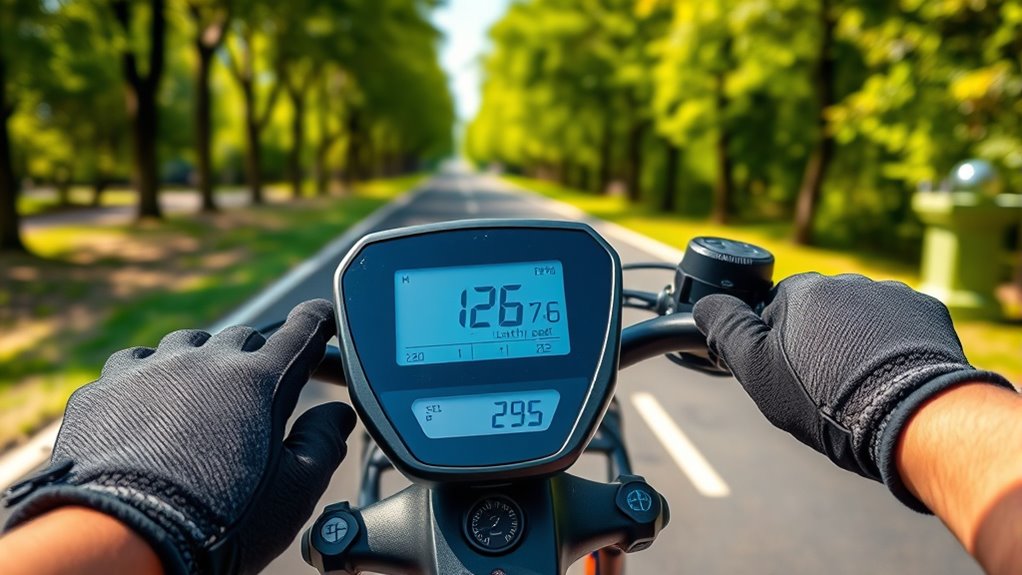
Before starting your test, note your e-bike’s battery percentage to guarantee consistency. Set the initial assist level to the same setting each time for accurate comparisons. Recording these starting conditions helps you measure range reliably each time you ride. Additionally, ensure your tires are properly inflated and free of debris, as bike maintenance can significantly impact your range.
Battery State at Start
How you start your ride can considerably impact the accuracy of your range measurement. Before setting off, check your battery’s charge level and note the battery voltage. A full or nearly full charge ensures consistent starting conditions, reducing variability in your results. Record the exact charge level percentage and the current battery voltage displayed on your e-bike’s monitor. This data helps you compare starting conditions across different tests and understand how initial battery state influences range. Keep in mind that a lower charge level or a battery with fluctuating voltage can lead to inaccurate estimations. Additionally, understanding how battery management systems operate can help you interpret voltage readings more effectively. By consistently noting these starting parameters, you’ll create a reliable baseline for measuring your e-bike’s true range more accurately.
Initial Assist Level Setting
Setting the initial assist level on your e-bike directly impacts the consistency of your range measurements. To guarantee accurate results, you need to calibrate the assist level properly and maintain rider effort consistency. Start by selecting a steady assist level that you’ll use throughout the test, avoiding sudden changes. This helps prevent variations caused by assist level calibration errors. Make sure your assist setting reflects your typical riding style, whether you prefer a low or high assist. Consistent rider effort is essential; pedal with the same force each time to minimize variables. Document the assist level and riding conditions before starting. This way, your range test accounts for all initial settings, providing a reliable basis for accurate range measurement. Additionally, understanding the importance of spiritual practices like meditation can help improve focus and mental clarity during your testing process.
Monitor Power Usage During Your Ride
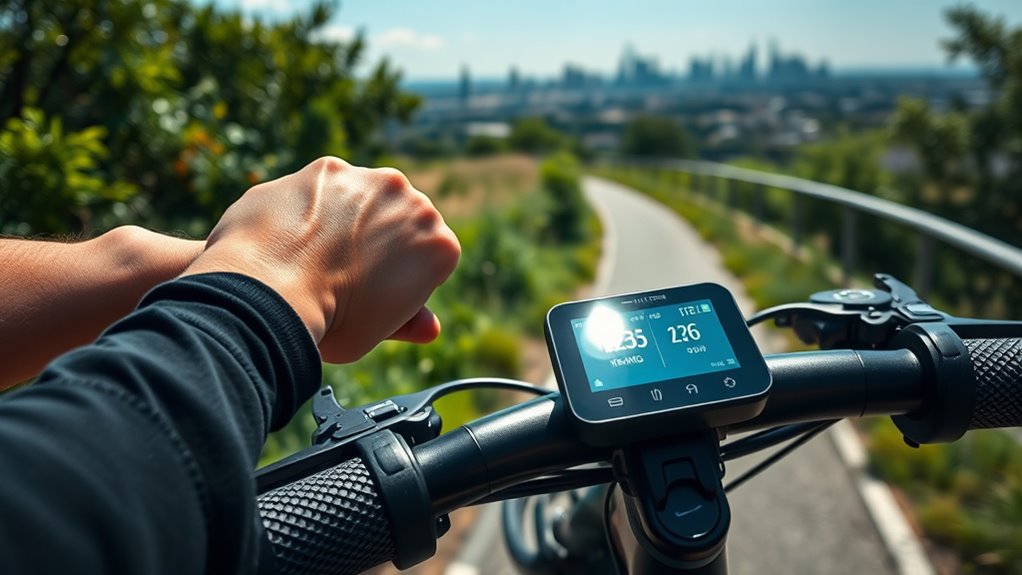
Monitoring your power usage during a ride provides real-time insights into how much energy your e-bike consumes. This helps you gauge battery health and maintain riding comfort by adjusting your effort when necessary. By keeping an eye on energy draw, you prevent unexpected drops in power and extend your ride. Use your bike’s display or a compatible app to track variables like wattage and current draw. Here’s a simple overview:
| Power Level | Estimated Range | Impact on Battery Health |
|---|---|---|
| Low | Longer rides | Gentle on battery |
| Moderate | Balanced | Maintains battery life |
| High | Short rides | Accelerates battery wear |
| Max | Quick acceleration | Increased power drain |
| Cruise | Consistent speed | Ideal comfort |
This awareness ensures you maximize range while preserving battery longevity.
Track Distance and Battery Consumption

Keeping track of the distance you travel and how much battery you’ve used is essential for estimating your e-bike’s remaining range. Start by recording the miles or kilometers after each ride. Use a bike computer or smartphone app to monitor your trip distance accurately. To guarantee precise battery consumption data, perform regular battery calibration, which helps your battery meter reflect real capacity. Check your tire pressure before each ride, as underinflated tires increase rolling resistance and drain more battery. Maintaining proper tire pressure and calibrating your battery will give you more reliable readings of your actual battery use. Additionally, understanding cookie categories and how they impact data collection can help you better interpret your ride metrics and improve your overall tracking accuracy. By consistently tracking your ride distance and battery consumption, you’ll develop a clearer understanding of your e-bike’s true range under different conditions.
Repeat the Test Under Different Conditions
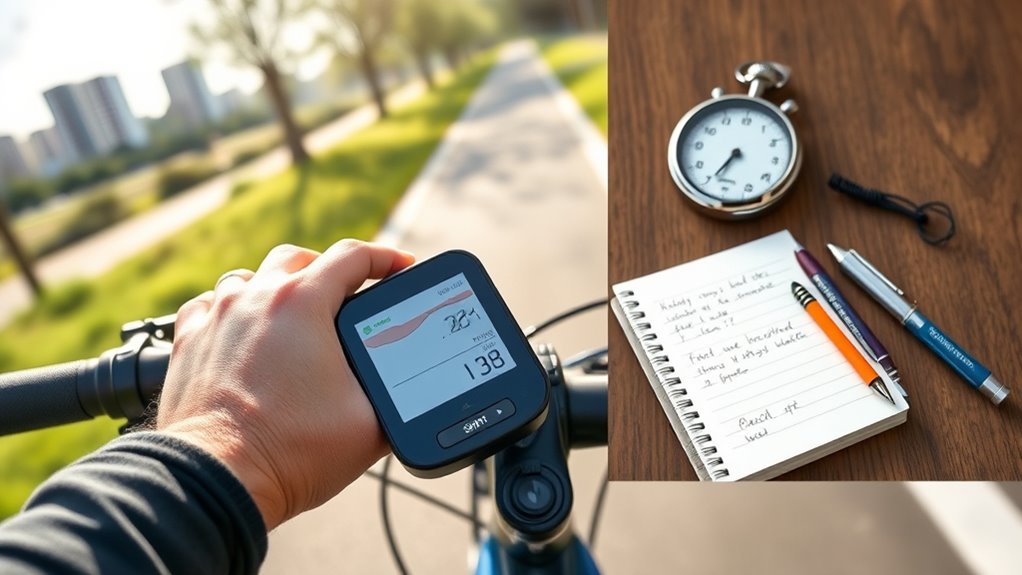
To get an all-encompassing understanding of your e-bike’s range, you should repeat your tests under various conditions. Weather variations, such as wind, rain, or temperature changes, can profoundly impact your battery life. Testing in different weather helps you see how these factors influence range. Additionally, consider terrain effects; riding on flat roads versus hilly or rough terrain can cause noticeable differences. By conducting multiple tests in diverse conditions, you’ll gather more accurate data on how your e-bike performs in real-world scenarios. This approach ensures your range estimates are realistic and reliable, enabling you to plan rides better and avoid unexpected battery depletion. Understanding how terrain type affects your range can help you optimize your riding strategy and battery usage. Adjust your expectations based on these variations for a more precise understanding of your e-bike’s capabilities.
Analyze Data to Determine Average Range

Once you’ve collected multiple range test results, analyzing the data is essential to determine your e-bike’s average performance. Focus on ensuring consistent riding conditions and proper battery calibration across tests. To accurately analyze, consider these steps: 1. Calculate the mean of all tested ranges to find the average range. 2. Identify any outliers caused by inconsistent riding or battery issues. 3. Adjust for factors like riding consistency and battery calibration to refine your estimate. Additionally, understanding battery health can help you interpret the data more accurately.
Use Apps or Built-in Tools for Accurate Data
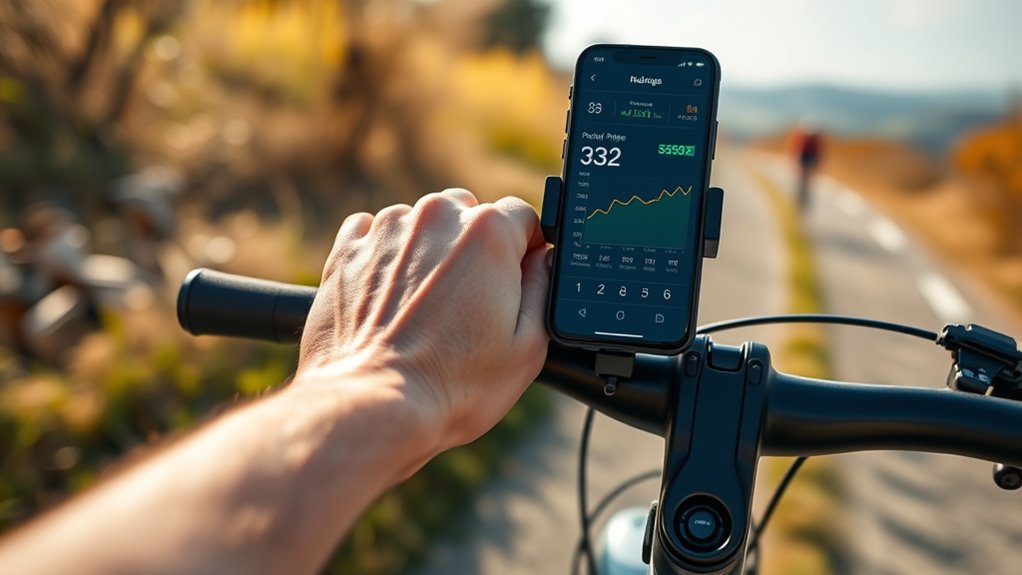
Using apps or your bike’s built-in tools can give you precise insights into your range. Check if the app is compatible with your e-bike and monitor battery usage during rides. Analyzing this data helps you understand how far you can go on a single charge. Incorporating performance tuning techniques can further optimize your e-bike’s efficiency and extend its range.
App Compatibility Checks
Because accurate range measurement depends on detailed data, checking app compatibility is essential. Ensuring your app can access key bike data improves battery management and measurement accuracy. To do this effectively, verify that your app supports:
- Real-time data sync with your e-bike’s system
- Compatibility with your bike’s manufacturer and model
- Access to detailed metrics like power output and battery status
If the app isn’t fully compatible, you may miss critical information, leading to inaccurate range estimates. Most built-in tools or third-party apps specify supported devices, so double-check before relying on them. Proper app compatibility guarantees you get precise data, which is crucial for managing your e-bike’s range effectively. This step helps you avoid errors and ensures your measurements are reliable. Additionally, understanding energy consumption patterns can further enhance your ability to estimate range accurately.
Monitoring Battery Usage
Monitoring your e-bike’s battery usage is essential for obtaining accurate range estimates. Use apps or built-in tools to track real-time battery levels and consumption patterns. Regular battery calibration helps make certain your readings stay precise, preventing inaccurate range predictions. Power management features allow you to optimize energy use, giving you better control over how much battery you consume per ride. By actively monitoring these metrics, you can identify when your battery is underperforming or needs maintenance. Consistent data collection helps you understand how different terrains, speeds, and assist levels impact your range. This insight enables you to plan rides more accurately and avoid unexpected battery depletion. Incorporating these tools into your routine ensures you get the most reliable information about your e-bike’s battery health and usage. Proper understanding of battery capacity and how it varies with usage conditions is crucial for maximizing your e-bike’s performance.
Analyzing Ride Data
Analyzing ride data with apps or built-in tools helps you understand how your riding habits affect battery performance. These tools track key metrics, revealing patterns that influence battery capacity and terrain impact. By reviewing this data, you can identify:
- How different terrains, like hills or flat roads, impact your battery life
- The effect of riding speed and acceleration on battery drain
- How varying assist levels alter overall range
- The importance of monitoring power management systems to optimize battery longevity
With this insight, you can optimize your routes, adjust riding styles, and better estimate your e‑bike’s actual range. Monitoring these factors helps you make smarter decisions, ensuring you get the most out of each charge and extending your battery’s lifespan. Accurate ride data is essential for precise range measurement and efficient e‑bike use.
Keep a Log for Future Reference
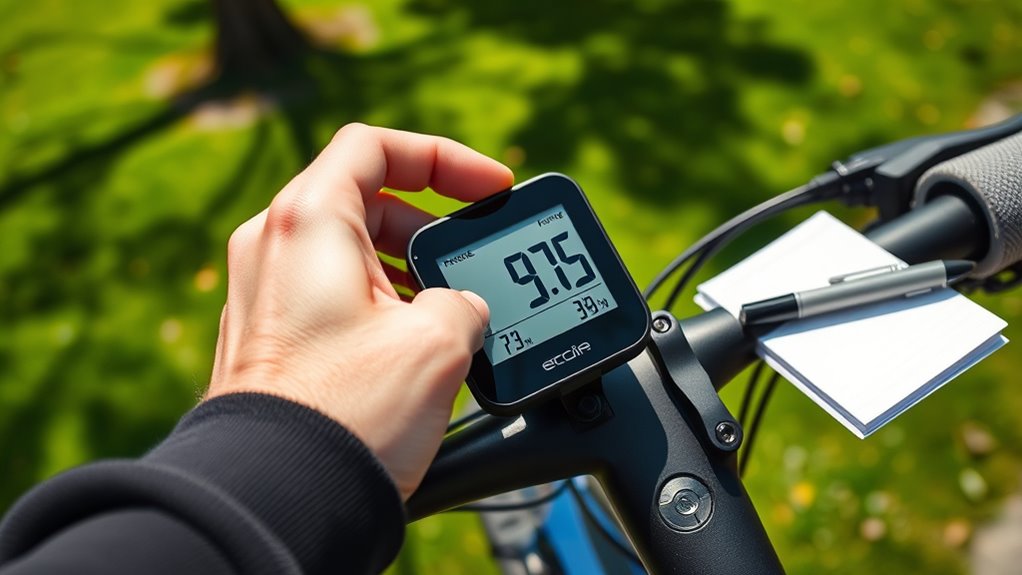
Keeping a detailed log of your e-bike rides is essential for understanding your bike’s actual range. By tracking each trip, you can identify patterns that affect battery performance and lifespan. Note ride distance, terrain, weather conditions, and assist level used. This information helps you refine your riding style to optimize range and extend your battery’s lifespan. Additionally, maintaining a log makes it easier to follow your maintenance schedule, ensuring timely checks on tire pressure, brake efficiency, and battery health. Over time, you’ll notice how different factors impact your ride, allowing you to adjust accordingly. Recording arcade machine usage can also provide insights into how extended gaming sessions may influence your overall energy levels and maintenance needs. A well-kept record not only improves your riding accuracy but also helps you plan future trips more effectively, maximizing your e-bike’s performance and longevity.
Frequently Asked Questions
How Does Temperature Affect E-Bike Range Accuracy?
Temperature affects your e-bike’s range accuracy because it influences battery calibration and sensor precision. When it’s cold, the battery’s chemical reactions slow down, reducing capacity and causing the sensors to give less accurate readings. Hot temperatures can cause the battery to deteriorate faster, also skewing your range estimates. By understanding these effects, you can better interpret your e-bike’s performance and make adjustments for more accurate range estimations.
Can Rider Weight Impact the Test Results?
Rider weight can definitely impact your test results because heavier riders require more power, which reduces range. To guarantee test consistency, keep rider weight the same across all tests. If you’re comparing different e-bikes or conditions, try to maintain a consistent rider weight to get accurate, comparable results. This way, variations in range truly reflect differences in the bikes rather than changes in rider weight.
How Do Different Terrains Influence Range Measurements?
Imagine hitting the trail, and suddenly, your e-bike’s range drops unexpectedly. Terrain variability plays a huge role here—rough or hilly surfaces drain your battery faster, skewing your measurements. To keep it accurate, you need proper battery calibration and consistent terrain conditions. Different terrains challenge your bike’s efficiency, so knowing how each affects range helps you plan better, ensuring your tests reflect real-world performance.
What’S the Best Way to Account for Wind Resistance?
To account for wind resistance, you should consider aero drag and wind speed. When riding, note the wind conditions and how they affect your bike’s effort. Use a weather app or an anemometer to measure wind speed, and adjust your range estimates accordingly. Riding into headwinds increases aero drag, reducing your range, so plan for extra battery life on windy days. Consistently tracking these factors helps you get more accurate range estimates.
How Often Should I Retest to Ensure Accurate Readings?
Did you know that batteries can lose up to 20% of their capacity over time? To keep your readings accurate, you should retest your e-bike range every 3-6 months. Regular battery calibration and data logging help track performance trends, ensuring your estimates stay reliable. This way, you can adjust riding habits or plan for replacements, preserving your e-bike’s efficiency and extending its lifespan.
Conclusion
By following these steps, you’ll get a clear picture of your e-bike’s true range, much like charting a course through uncharted waters. Keep detailed records and test under different conditions to understand your bike’s limits. This way, you’ll ride confidently, knowing exactly how far you can go before needing a recharge. Accurate measurements help you make smarter rides, turning every trip into a smooth journey rather than a surprise detour.
